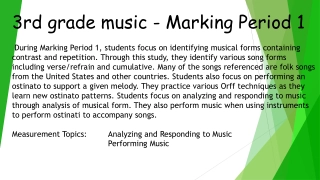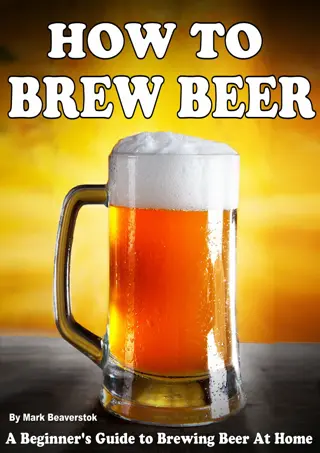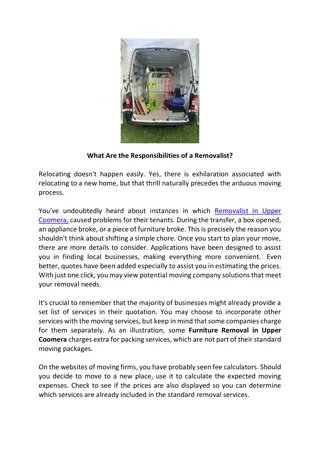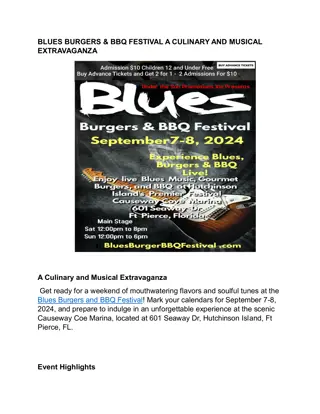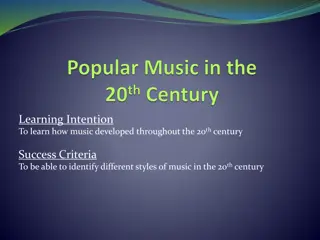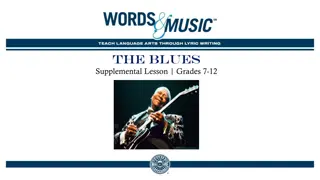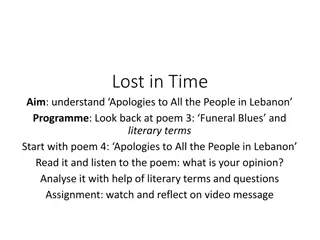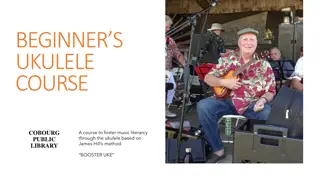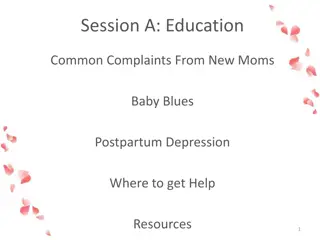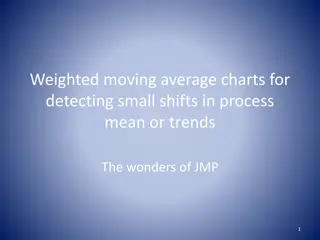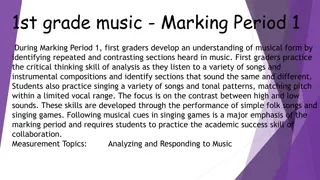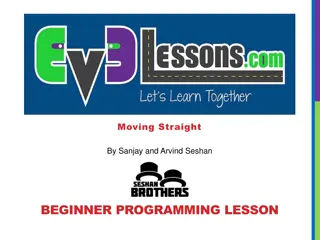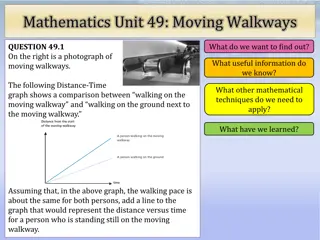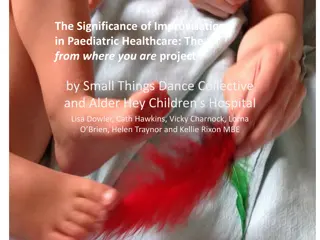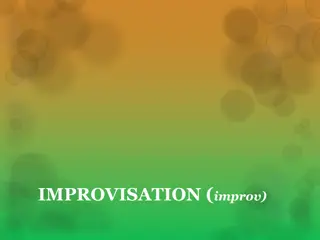Enhancing Beginner Improvisation Skills: Moving Beyond the Blues
Explore ideas to improve beginner improvisation skills by moving beyond basic blues scales to chords, modes, and melodic approaches. Understand the pros and cons of different methods to help young jazz musicians develop their improvisational abilities effectively.
Download Presentation

Please find below an Image/Link to download the presentation.
The content on the website is provided AS IS for your information and personal use only. It may not be sold, licensed, or shared on other websites without obtaining consent from the author.If you encounter any issues during the download, it is possible that the publisher has removed the file from their server.
You are allowed to download the files provided on this website for personal or commercial use, subject to the condition that they are used lawfully. All files are the property of their respective owners.
The content on the website is provided AS IS for your information and personal use only. It may not be sold, licensed, or shared on other websites without obtaining consent from the author.
E N D
Presentation Transcript
Going Beyond the Blues IDEAS FOR IMPROVING BEGINNER IMPROVISATION OMEA OPUS 100 Nov. 8, 2019 Glenn Waugh Medway H.S. Thames Valley DSB
Where we're coming from... Too basic: Too complex: - using the blues scale as foundation - attempts to follow "the changes" - one-size-fits-all method - even in simple charts, this assumes a lot - "every note sounds good" - really? - can bog down a tune tempo-wise - confidence vs. competence - knowledge vs. ability
The Basic Approach: The Blues Scale (1 - b3 4 - b5 5 - b7 1) Pros Cons Even this assumes a theory language that is often beyond that of the young improviser - may only know one octave of one major scale scale degrees, semitones, etc. Not all blues is minor-blues Need to be careful with certain notes if it is a major- blues form Needs careful repertoire planning by teachers choosing all minor-blues charts, or altering the scale Breaks down as soon as you exit the blues major-key, Rhythm changes, or harmonic-minor tunes will all sound "off" Solos can be choppy and disconnected Larger leaps and intervals can be hard, esp. for brass pitching Great for the blues, which is a foundational aspect of jazz Works well in minor keys that feature dominant 7th chords (incl. on the I chord) True that all, or most, notes will sound good over a minor blues Good to develop rhythm- focused, pattern-based solos with repetitive "licks" or "riffs" as a starting point great for first-time improvisers
The "Real" Jazz Approach: Chords, Modes, or "Playing the Changes" Pros Cons True that this is the foundation of real jazz improvisation Introducing the idea of "chord tones" when students likely won't have been introduced to the idea of chords To do this correctly, need to teach chord construction, arpeggiation, and 7thchords/extensions - fairly advanced for a young student Introduces students to the idea of chords and how song form works Want to introduce improvisation early in a young jazz musician s training most gr.9-10 students will have limited knowledge beyond (maybe) major and minor scales Helps connect theory lesson information to real-world playing If successful, solos will sound far more legit and professional Triads are often in senior grades, as are 7th chords (if at all) Modes have some simpler aspects, but are still a complex concept for a young student to grasp Can connect to transcriptions for analysis of what players are doing on recordings we hear Assumes private instruction/theory and requires student- driven learning in most cases
Melodic Improvisation "Start where they are..." Aiming for more linear, melodically-oriented solos Uses knowledge of major scales as the basis for improvisation, rather than new concepts such as numbered scale degrees with intervallic jumps (Blues) or chord construction (changes) Reasons are twofold: 2) Eliminates "jumpiness" of the blues scale esp. fr brass 1) Familiarity with patterns of the major scale, both under their fingers and in their ears No gaps in the scale no intervallic jumps (minor 3rds) to negotiate This familiarity should help with expressive and creative capabilities
Where Do They Need To Be To Start? Two sets of skills are needed: Knowledge of Chromatic Scale/Semitones Mastery of Required Major Scales able to play the chromatic scale on their instrument fluidly from memory not of every scale, or every mode just the one or two major scales that will fit over the original melody (depends on tune) most grade 9 students should be able to do this chromatic scale is necessary because the addition of chromatic passing notes to the major scale is a fundamental quality of linear bebop improvisation from memory, with speed, starting on various notes in various patterns vary based on the age and ability of the students
Linear Melodic Improvisation Major Key Tunes Great starting point lots of great tunes are based in major tonality Using a standard major scale is less scary than having to figure out something new, such as the pattern of the blues scale, using intervals and unfamiliar leaps One addition - chromatic passing note at the top of the scale two 7ths, one major, one minor (flat 7) Ex. Concert Bb major scale would have both A flat and A natural, creating four chromatic notes at the top of the scale The reason for using step chromatic tones is so that the chord tones fall on all the strong beats in a measure. [...] Chromatic tones in the 8thnote scale can be thought of as hinge tones. It is important to hinge one scale to another. [...] Using the 8thnote scale in this way will provide the much needed line direction, or as sometimes called, forward motion in the melodic line. (Riposo 38) This idea of forward momentum, or melodic line direction, is the major disadvantage of over-reliance on the blues scale
Exercises with major scales: 1. Scale w/2-7ths 2. Desc. Exercise 3. Pattern Exercise
Linear Melodic Improvisation Major Key Tunes (cont'd) Often the entire head of the tune can be improvised on using just this major scale, with the addition of chromatic passing tones leading between chord tones (for example, leading to 3, between 4 and 5, etc.) - this is where knowledge of the chromatic scale comes in Many American Songbook standards can be approached with this melodic improvisation method "Fly Me to the Moon" and "Nearness of You" are two examples Exception is Rhythm Changes (based on Gershwin's "I Got Rhythm" chord changes), where the bridge needs special attention as it uses cycling major scales moving in 5ths ex. "Oleo" by Sonny Rollins
Fly Me To the Moon Melody is essentially a descending major scale, played 5 notes at a time Adding chromatic notes allows for greater interest and connective motion
Nearness of You Again, melody is essentially a major scale played in a pattern
Linear Melodic Improvisation Minor Key and Blues Tunes Blues scale is still a good starting place Adding the 2ndnote of the scale (or 9th, if you prefer) immediately expands the melodic possibilities for linear improvisation Works especially well as a 9thin the second octave, after moving up through the blues scale (Coltrane opening lick of "So What" solo) In the first octave, smooths out the leaps (minor 3rds) of the blues scale Creates a more traditional minor scale sound on the first 5 notes Often advisable to still avoid the sixth degree Experiment with minor 7th and major 7th, depending on the tune Minor 7th is best on dominant harmonies/blues, while the "harmonic minor" sound of the major/raised 7th fits many more traditional ballads
Summertime Blues scale Blues scale with added 2nd (in melody) Blues scale progression up to 9th
Jazz Phrasing To swing or not to swing...? Slurring rather than tonguing, generally at first using tongue to delineate phrase, or for accent, but not all the time avoid choppiness Swing eighth-notes should be primarily when playing as an ensemble the "triplet"-feel swing should usually be avoided in solos When you listen carefully, many improvised solos, especially from the be-bop era forward, are actually played with straight-eighths "The unique "feel" in jazz improvisation comes from the tension between the swung-eighths in the rhythm section against the straight-eighths in the improvised solo" (Andrew Scott, Associate Dean of Music, Humber College)
Jazz Phrasing To swing or not to swing...? Oleo - Miles Davis - Bags' Groove version Pent-Up - House - Cifford Brown and Sonny Rollins Joy Spring - Clifford Brown Jordu - Clifford Brown Look for the Silver Lining - Chet Baker (Last Great Concert)
Jazz Phrasing "Backphrasing" Bebop slur pattern of tonguing the off-beat, slurring into the beat when playing eighth note scalar patterns Takes a lot of time work on scale patterns with this articulation Avoid clipping the second note don t want choppy, needs to remain smooth at the back end of the slur NOT GOOD
Jazz Listening Considerations Too often we direct students to artists, without considering the need to direct them to specific albums, tunes, or eras of that artist "Trumpet players should listen to Miles Davis" (Great Bitches Brew? Doo- Bop? Probably not...but earlier Miles Davis is far more accessible and mimic-able) "and Maynard Ferguson" (amazing but is there a point to a grade 9 spending a lot of time listening to that, when their range is one octave, beyond inspiration? May even instill bad habits if trying to mimic without the requisite building blocks and process work) "Sax players should listen to Coltrane" (need to be specific probably earlier stuff, more mainstream only the more musically advanced will be able to deal with more experimental works, which are the bulk of his more celebrated recordings) "and Charlie Parker" (if I m a grade 9 alto player, this would seem both excessive and impossible maybe inspirational, but also might turn them off)
Jazz Listening Considerations (cont'd) Need to be very specific with listening advice Find legit jazz recordings/artists/albums, but that have an attainable aspect to them something they can emulate at their own level Amazing stuff is amazing, but is so far out of the realm for most kids that it is far more an inspiration than a model Doesn t need to be instrument specific good to have models for tone, etc. but for style, phrasing, ideas, instrument matters much less than we think Doesn't have to be SLOW, but need to start with simpler, melodic improvisation rather than complex, outside-the-box playing
Jazz Listening Considerations (cont'd) Often the early recordings, etc. by an artist are more attainable As well, some of the "second-tier" players tended to stay more "in-the-box" than their more innovative counterparts, making their recordings more accessible throughout their careers (Kenny Dorham, Art Farmer, Joe Henderson, Benny Golson) Some Albums to Check Out for Improv Style Miles Davis Best of the Capital/Blue Note Years Miles Davis Quintet Cookin', Relaxin', Workin', Walkin' Chet Baker Best of Chet Baker Plays and Sings, Last Great Concert Art Blakey Jazz Messengers Night at Birdland, Caf Bohemia, self-titled Clifford Brown and Max Roach album on Verve, At Basin Street Sonny Rollins Sonny Rollins +4
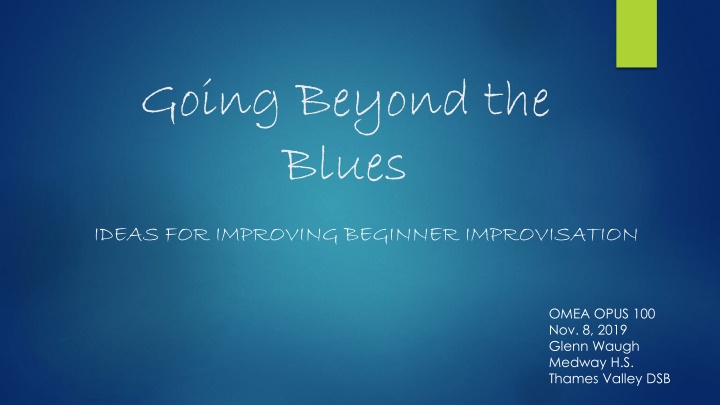

![[PDF⚡READ❤ONLINE] Zen Mind, Beginner's Mind: 50th Anniversary Edition](/thumb/20459/pdf-read-online-zen-mind-beginner-s-mind-50th-anniversary-edition.jpg)
